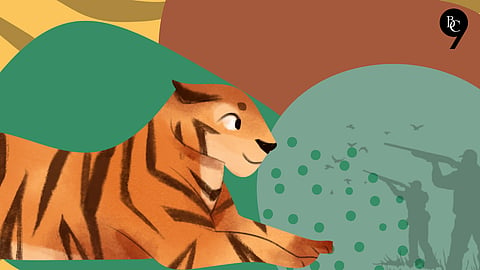

The global community is now learning to live with the 'new normal'. Over the last few months, there has been increased discourse about mindfulness, ensuring good mental and physical health. But to the wildlife population in India, the last few months have meant an increase in the risk of death.
According to a report published by traffic.org, India reported an increase in poaching activities during the COVID-19 lockdown.
The reason for this was primarily the need for animal meat, and the percentage jumped from nearly eight out of 35 (22 per cent) total reported cases during pre-lockdown, to 39 out of 88 (44 per cent) during the lockdown period. Poaching cases for small mammals including hares, porcupines, pangolins, giant squirrels, civets, monkeys, smaller wild cats rose from 6 (17 per cent) to 22 (25 per cent) between the pre-and lockdown periods.
Tiger Trade in India
Tigers were once a symbol of national pride and an integral part of India's rich cultural heritage. They are also India's National Animal. However, tigers have now been listed endangered by IUCN.
"Tiger poaching is driven by the increased demand for tiger body parts by international wildlife traffickers in the world. Other factors affecting wild tigers is the shrinking and fragmentation of their habitat. Apart from that, it also includes the loss of their natural prey in the forests -- which is caused by poaching," said Mr Kartick Satyanarayan, Founder of Wildlife SOS, an organisation working towards conserving India's natural heritage, forest and wildlife wealth.
But conservation organisations and activists also face a lot of issues when dealing with wildlife. Recently, Assam's Forest Minister also spoke against the newly imposed ban on beef for zoo animals.
Activist Satyanarayan says, "The challenges faced are on many levels, starting with rigid mindsets of people and fighting old traditions. Other challenges include the financial resources to help wild animals in distress, delays in prosecution often caused by red tape, wildlife criminals using loopholes in the law to escape punishment for their crimes, limitations by way of veterinary equipment, vehicles, medicines etc."
"It is extremely challenging to run a non-profit organisation and to find people committed to the cause. Creating public awareness is a big challenge," he added.
Efforts of the local community
"We work closely with local indigenous communities who have historically been hunter-gatherers and work to help improve their quality of life while promoting co-existence with wildlife and encourage community participation for long-term sustainable conservation success," says Mr Satyanarayan.
Additionally, it also acts as an employment opportunity for the local community. "For example, we provide alternative employment to snake charmer communities so they don't need to exploit snakes! We also work in collaboration with the forest department to launch education and awareness programs especially for communities living in conflict-prone areas," adds Kartick.
Changes over the year
Endless efforts in the last few years have increased awareness regarding the plight of tigers and the country has seen some positive developments.
The Wildlife SOS founder says, "Yes! I've certainly noticed a very positive change in people with time. Take the Wildlife SOS hotline for example. We receive hundreds of calls each month about wild animals in distress."
Previously, people were afraid of wildlife presence, but now there is an increase in reporting. This helps in protecting all kinds of wild animals.
Kartick stresses that India is home to about 70 per cent of the world's tiger population, thereby making our role in ensuring the survival of this species crucial. If we lose the tiger, the loss would be irreversible and shameful.
"The need of the hour is public education. The fact that we have wild tigers, elephants, leopards, bears and a wealth of wildlife living check to jowl amidst us in one of the most densely populated countries in the world is a sign there is still hope and if each one of us does the right thing to help protect and conserve wildlife then we can certainly make a difference," he says.
Initiatives taken
Initiatives are being taken around the world to curb the poaching and hunting, but the majestic animal remains endangered.
Sony BBC Earth has stepped forward to highlight the issue of illegal tiger trade in Asia. Exploring through the secrets of illegal tiger farms, and the power players who profit, it is an expose on the tiger traffickers.
Former Royal Marine Commando Aldo Kane uncovers key trafficking routes connecting Malaysia, China, Thailand, Laos and Vietnam, filming the traffickers, and meeting those trying to stop them.
Mr Kartick Satyanarayan has associated with the show to throw light on the reality of illegal animal trafficking that threatens wildlife in India.
Watch: Tiger's: Hunting the Traffickers
Where: Sony BBC Earth
When: 17th October, 10.00 pm
